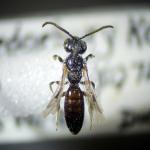This is a minute species, superficially resembling Lasioglossum minutissimum (Kirby). It may have been overlooked at times because of its small size.
A southern species found sparingly in south-east England. There is no indication that it is increasing its range (Falk, 1991).
Most of Europe, north to Lithuania and the middle of Sweden and east to Kyrgyzstan.
Not listed in the Red Data Book (Shirt, 1987) but given Rare (RDB3) status in Falk (1991).
This bee inhabits mainly open woodland with clearings, both on sandy and gravelly soils.
The female flies from April to early September. The start date for the male flight period is uncertain due to lack of data but it will fly until early September, with an exceptionally late date being October 1st.
This is likely to be a solitary species. The female has been found nesting in low sandy banks (pers. obs.) and in level ground (G H L Dicker, unpublished notebook). No more is known about the nesting biology.
The bee has been observed visiting yellow-flowered Asteraceae and a cinquefoil (pers. obs.). These may possibly also represent pollen sources.
There are no recorded British parasites, but Sphecodes marginatus von Hagens (found in the Channel Islands) may possibly use this species as a host in continental Europe.
2019


